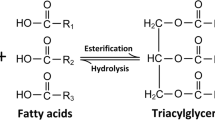Abstract
Selective hydrolysis of borage oil byCandida rugosa lipase immobilized on microporous polypropylene was carried out in an iso-octane-water two-phase system in order to obtain glycerides rich in γ-linolenic acid (GLA). Lipase was immobilized on hydrophobic microporous polypropylene supports by physical adsorption, γ-linolenic acid content in the unhydrolyzed acylglycerols could be raised to 51.7 mol% from an initial content of 23.6 mol% in borage oil with a yield of 59%. A simplified kinetic model was proposed for this selective hydrolysis. The Michaelis constantK M and the maximal-rate constantV max are 0.107M and 393.9 U/mg-protein, respectively. Product inhibition with a dissociation constant of the enzyme-product complexK I = 25 mM was confirmed. Some properties of the immobilized lipase were also examined.
Similar content being viewed by others
Abbreviations
- ES*:
-
complex of enzyme and substrate molecules
- K I total mass of enzyme in the reactor (mg):
-
kcat
- rate constant in the Michaelis-Menten equation (mmol/min mg protein):
-
K I dissociation constant for the complex EP* (M)
- K M :
-
apparent Michaelis constant (M)
- P:
-
oleic acid concentration (M)
- Po :
-
initial concentration of oleic acid (mM)
- S:
-
substrate concentration (M)
- So :
-
initial value of S (M)
- t:
-
reaction time (min)
- Vi :
-
initial velocity of reaction (µmol/min)
- Vmax :
-
apparent maximal velocity (µmol/min)
References
Brennender, R. R. (1987), inCRC Handbook of Eicosanoids: Prostaglandins and Related Lipids, vol. 1, part A, Willis, A. L., ed., CRC Press Inc., pp. 99–117.
Scott, J. (1989),Curr. Therapeut, pp. 45–46.
Barber, A. J. (1988),Pharmaceut. J. 240, 723–725.
Jantti, J., Seppala, E., Vapaatalo, H., and Isomaki, H. (1989),Clin. Rheumatol. 8, 238–244.
Traitler, H., Wille, H. J., and Studer, A. (1988),J. Am. Oil Chem. Soc. 65, 755–758.
Arai, M., Fukuta, H., and Morikwa, H. (1987),J. Ferment. Technol. 65, 569–573.
Yokochi, T., Usita, M. T., Kamisaka, Y., Nakahara, T., and Suzuki, O. (1990),J. Am. Oil Chem. Soc. 67, 846–851.
Mukherjee, K. D. and Kiewitt, I. (1991),Appl. Microbiol. Biotechnol. 35, 579–584.
Rahmatullah, M. S. K. S., Shukla, V. K. S., and Mukherjee, K. D. (1994),J. Am. Oil Chem. Soc. 71, 563–567.
Rahmatullah, M. S. K. S., Shukla, V. K. S., and Mukherjee, K. D. (1994),J. Am. Oil Chem. Soc. 71, 569–573.
Hills, M. J., Kiewitt, I., and Mukherjee, K. D. (1989),Biotechnol. Letters 2, 629–632.
Brink, L. E. S., Tramper, J., Luben, K. Ch. A. M., and Van’t Riet, K. (1988),Enzyme Microb. Technol. 10, 736–743.
Dordick, J. S. (1991), inApplied Biocatalysis, Blanch, H. W. and Clark, D. S., ed., Marcel Dekker, New York, pp. 1–51.
Brockerhoff, H. (1971),J. Biol. Chem. 246, 5828–5831.
Ghatorae, A. S., Bell, G., and Hailing, P. J. (1994),Biotechnol. Bioeng. 43, 331–336.
Brady, C., Metcalfe, L., Slaboszewski, D., and Frank, D. (1988),J. Am. Oil Chem. Soc. 65, 917–921.
Otero, C., Pastor, E., Fernandez, V. M., and Ballesteros, A. (1990),App. Biochem. Biotechnol. 23, 237–247.
Ructenstein, E. and Wang, X. (1993),Biotechnol. Tech. 7, 117–122.
Malcata, F. X., Reyes, H. R., Garcia, H. S., Hill, C. G., Jr., and Amundson, C.H. (1990),J. Am. Oil Chem. Soc. 67, 890–910.
Huang, F. C. and Ju, Y. H. (1994),Biotechnol. Tech. 8, 827–830.
Lowry, R. R. and Tinsley, I. J. (1976),J. Am. Oil Chem. Soc. 53, 470–172.
Yamauchi, K., Tanabe, T., and Kinoshita, M. (1979),J. Org. Chem. 44, 638–639.
Author information
Authors and Affiliations
Corresponding author
Rights and permissions
About this article
Cite this article
Huang, FC., Ju, YH. & Huang, Cw. Enrichment in γ-linolenic acid of acylglycerols by the selective hydrolysis of borage oil. Appl Biochem Biotechnol 67, 227–236 (1997). https://doi.org/10.1007/BF02788800
Received:
Accepted:
Issue Date:
DOI: https://doi.org/10.1007/BF02788800




